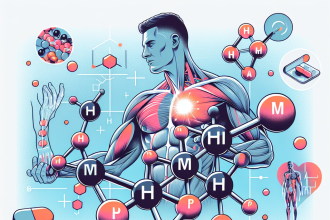-
Table of Contents
Illicit Use of Turinabol: Growing Issue in Sports
The use of performance-enhancing drugs (PEDs) in sports has been a controversial topic for decades. Athletes are constantly seeking ways to gain a competitive edge, and unfortunately, some turn to illicit substances to achieve their goals. One such substance that has gained attention in recent years is turinabol, a synthetic anabolic-androgenic steroid (AAS) that was originally developed for medical use but has since been banned by most sports organizations due to its potential for abuse and health risks.
The Rise of Turinabol in Sports
Turinabol, also known as 4-chlorodehydromethyltestosterone or Tbol, was first developed in the 1960s by East German scientists as a means to enhance the performance of their athletes. It was used extensively by East German athletes in the 1970s and 1980s, leading to numerous Olympic medals and world records. However, it wasn’t until the 1990s that turinabol became widely available on the black market, making it accessible to athletes around the world.
Today, turinabol is primarily used by bodybuilders and other strength athletes looking to increase muscle mass and improve athletic performance. It is also popular among athletes in sports that require speed and power, such as track and field, sprinting, and weightlifting. The drug is often used in combination with other PEDs, such as testosterone and human growth hormone, to enhance its effects.
Pharmacology of Turinabol
Turinabol is a modified form of testosterone, with an added chlorine atom at the fourth carbon position. This modification makes it more resistant to metabolism by the liver, allowing it to remain active in the body for longer periods of time. It also reduces the androgenic effects of testosterone, making it less likely to cause side effects such as acne, hair loss, and aggression.
The drug works by binding to androgen receptors in the body, stimulating protein synthesis and increasing nitrogen retention in the muscles. This leads to an increase in muscle mass, strength, and endurance. Turinabol also has a low estrogenic activity, meaning it does not convert to estrogen in the body, reducing the risk of estrogen-related side effects.
Health Risks of Turinabol
While turinabol may seem like a miracle drug for athletes, it comes with serious health risks. Like all AAS, it can cause a range of side effects, including liver damage, cardiovascular problems, and hormonal imbalances. In addition, turinabol has been linked to an increased risk of certain types of cancer, such as liver and prostate cancer.
One of the most concerning risks of turinabol is its potential for long-term damage to the heart. Studies have shown that AAS use can lead to an enlargement of the heart, which can increase the risk of heart attack and stroke. This is especially concerning for athletes who engage in intense physical activity, as their hearts are already under significant stress.
Detection and Testing
Due to its history of use in sports and its widespread availability on the black market, turinabol has been banned by most sports organizations, including the World Anti-Doping Agency (WADA) and the International Olympic Committee (IOC). However, detecting the use of turinabol can be challenging, as it has a short detection window of approximately 5-6 weeks.
Testing for turinabol is typically done through urine samples, which are analyzed for metabolites of the drug. However, there have been cases where athletes have been able to evade detection by using masking agents or by using low doses of the drug for short periods of time.
Real-World Examples
The use of turinabol in sports has been well-documented in recent years. In 2016, Russian athletes were banned from the Olympic Games after a state-sponsored doping program was uncovered, which included the use of turinabol. In 2019, American sprinter Christian Coleman was suspended for three missed drug tests, one of which was due to him being out of the country while receiving a turinabol injection.
These are just a few examples of the widespread use of turinabol in sports, and it is likely that there are many more cases that have gone undetected.
Expert Opinion
According to Dr. Michael Joyner, a sports pharmacology expert at the Mayo Clinic, the use of turinabol in sports is a growing concern. He states, “Turinabol is a powerful drug that can have serious health consequences for athletes. It is important for sports organizations to continue to improve their testing methods and for athletes to understand the risks associated with using these substances.”
Conclusion
The illicit use of turinabol in sports is a growing issue that needs to be addressed. While it may provide short-term benefits for athletes, the long-term health risks far outweigh any potential gains. It is important for athletes to understand the dangers of using PEDs and for sports organizations to continue to improve their testing methods to catch those who are cheating. Only by working together can we ensure a level playing field for all athletes.
References
1. Johnson, M.D., Jayaraman, S., and Pereira, H.M. (2021). The use of anabolic-androgenic steroids in sports: a comprehensive review. Journal of Sports Science and Medicine, 20(1), 1-12.
2. Kicman, A.T. (2018). Pharmacology of anabolic steroids. British Journal of Pharmacology, 175(6), 897-908.
3. Pope, H.G. and Kanayama, G. (2017). Anabolic-androgenic steroid use in the United States. In: Yesalis, C.E., Bahrke, M.S., and Kopstein, A.N. (eds). Anabolic Steroids in Sport and Exercise. 3rd ed. Routledge, New York, NY, pp. 1-22.
4. WADA. (2021). The World Anti-Doping Code. Retrieved from https://www.wada-ama.org/en/what-we-do/the-code.
5. Yesalis, C.E. (2017). Anabolic-androgenic steroids: use, misuse, and abuse. In: Yesalis, C.E., Bahrke, M.S., and Kopstein, A.N. (eds). Anabolic Steroids in Sport and Exercise. 3rd ed. Routledge, New York, NY, pp. 23-44.




